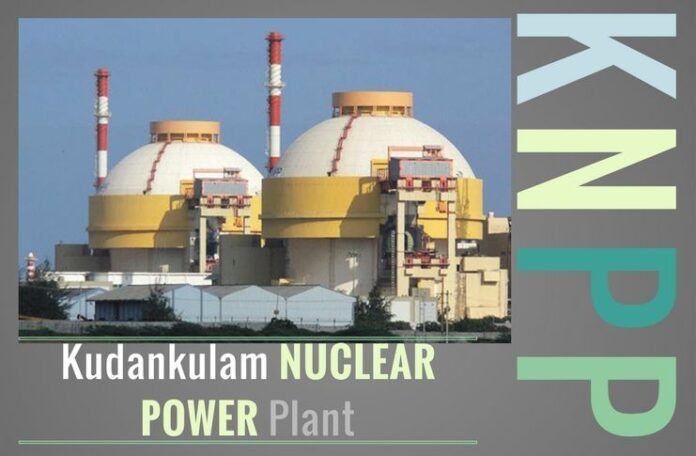
It took Indian and Russian nuclear power engineers fourteen years to set up the 1000 MW unit-one of the Kudankulam Nuclear Power Plant. But that did not affect the enthusiasm and happiness in the minds of Prime Minister Narendra Modi, Russian President Vladimir Putin and Tamil Nadu Chief Minister J Jayalalithaa in coming together on Wednesday in a rare video conference to dedicate the plant to Indo-Russian friendship and cooperation.
The saga of Kudankulam Nuclear Power Plant (KKNP for short) began in 1988 when the then Prime Minister of India, Rajiv Gandhi and the then President of the then Soviet Union Mikhail Gorbachev signed a treaty for setting up a 1000 MW nuclear power plant in India with the collaboration and financial aid provided by the Soviet Union.
It took some years for India to locate the site for the plant and the sprawling beach along Idnithakarai near Kudankulam village in Tirunelveli district was selected for setting up the plant. By that time much water has flown down the Volga and the once powerful Soviet Union disintegrated into smaller states. Gorbachev presided over the liquidation of the world’s largest country and since then there was total chaos and confusion.
By 2002, the India-Russia nuclear power deal was revived and works began for the construction of two units each of 1000 MW. It took 12 years for Nuclear Power Corporation of India Ltd to declare that the unit- one of the KKNP has become critical (In the parlance of nuclear power, a reactor is said to be critical when it is ready to generate power). The Unit-1 became critical in July 2013 and it started yielding power to the National Grid in October 2013. On December 31, 2014, the plant began commercial production.
But the euphoria was short lived as the plant had to be shut down suddenly in June 2015 for refuelling and maintenance. It took another eight months for the plant to resume power generation as the plant commenced power generation in January 2016. Since then the plant has been functioning without any hitch.
The uniqueness of the KKNP unit-1 is that it is the single largest nuclear power plant to be set up in India. Though the Nuclear Power Corporation of India Ltd, the public sector enterprises entrusted with the designing, fabrication and operation of the country’s nuclear reactors, own and operate 21 reactors, KKNP Unit-1 is the largest and biggest reactor under its fleet. The run-up to the commissioning of unit-one saw a series of agitations launched by the local fishermen community with the active support of the Church, the Maoists, Tamil extremists and a section of the media.
The Peoples Movement Against Nuclear Energy (PMANE) an umbrella organisation of all factions of anti-nuclear activists launched a massive agitation against the construction of the plant which literally brought Idinthakarai village to grinding halt. The then Prime Minister Manmohan Singh alleged that the activists were being funded by international agencies and NGOs. Instances of the leaders of the agitation getting foreign funds to sustain the stand-off were proved time and again by the investigating agencies. A former bureaucrat who was in the forefront of the agitation even spread a rumour that the Unit-one was a failure and the NPCIL engineers were cheating the people by generating power using diesel.
With the official dedication and commissioning of the unit-one on Wednesday, stage is set for the commissioning of unit-2 which also is of 1000 MW capacity. The unit attained criticality on July 10, 2016. “The reactor would start yielding power to the National Grid by August end,” R S Sundar, project director, KKNP, told PGurus over telephone from Kudankulam.
Since the gestation period (date of commencing power production from the date of groundbreaking) of nuclear power reactors is quite long, it may not be advisable for India, a country starved of power, to depend exclusively on nuclear power. Prime Minister Modi declared on Wednesday that four more nuclear reactors, each of 1000 MW, would come up at Kudankulam.
The inordinate delay in the commissioning of the 500 MW Prototype Fast Breeder Reactor coming up at Kalpakkam, 70 km north of Chennai is a matter of concern. Though the bosses of the Department of Atomic Enery have been claiming since 2005 that the PFBR would start commercial production by 2011, there is no sign of the reactor generating power even in 2016. Last week Jitendra Singh Minister in charge of Atomic Energy , told the Lok Sabha that the PFBR would be ready by 2017.This means that the Indian engineers need more than 12 years to set up a 500 MW fast breeder reactor in spite o their claims that they are the world leaders in Fast Breeder Reactor Technology.
The offer made by bosses of the FBR that they would be able to sell power at the rate of Rs 2.50 per unit too would remain a mirage as the delay in commissioning the plant has led to cost over run. India’s deadline with completion of nuclear power reactors need to be re-worked to make it more competitive.
- Subramanian Swamy approaches Supreme Court on Govt’s modification of 2G Scam Judgment to avoid auction of Satellite Spectrum - April 23, 2024
- Defence Minister Rajnath Singh visits Siachen. Reviews military preparedness - April 22, 2024
- Amit Shah’s shares in the Stock Market almost doubled in the past five years - April 21, 2024







